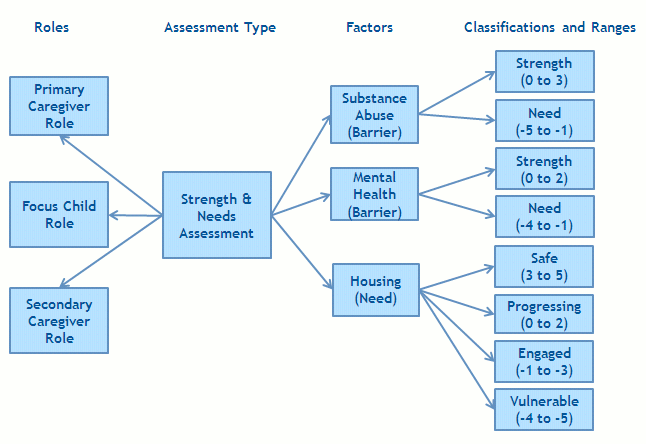Once the assessment factors that are applicable to an assessment are defined, they are categorized. At least one category must be specified for an assessment definition. Examples of assessment categories include need and barrier. Categorizing assessment factors effectively groups the factors that are applicable to the assessment by type. Each assessment category defines the type of factors that are applicable to an assessment. For example, housing, education, and shelter factors may be factors of type "need". Substance abuse and domestic violence may be considered factors of type "barrier". An assessment can consist of both need factors and barrier factors.
Factors are categorized in order to distinguish between the different types of factors that are included in each assessment and also to define the results that can be achieved by each client or group of clients when assessed for a particular factor. Each assessment has a set of factors which describe acceptable performance standards or range of results for that assessment. For example, a client assessed for the shelter factor may achieve one of the following results: In crisis, at risk, stable, or self sufficient. The range of results is used to measure a client or group's functioning in that factor. The range of results that can be achieved for each factor that is assessed are defined in application administration as classifications.
Barrier factors may be classified differently to need factors. For example, a client who is assessed for the need factor of housing may be classified as safe, progressing, engaged and vulnerable, whereas a client assessed for a barrier factor of substance abuse may be classified as need and strength.
Classifications must be specified for each category. All factors must fall into a particular category and all classifications defined for that category are applicable to all factors belonging to it. So, at the factor level it is not possible to enter different classifications.
An administrator can however apply different ranges to each classification across different factors. For example, substance abuse (barrier) can be classified as need (-5 to -1) and strength (0 to 3). Mental health (barrier) can be classified as need (-4 to -1) and strength (0 to 2) i.e. different ranges can be applied to each classification of a factor.
The figure below shows an example of the structure of an assessment and the categorization and classifications of factors within that assessment.

If some of the classifications associated with the category are not applicable for a factor, then the administrator should not specify ranges for that classification so that they are not displayed in any assessment results.